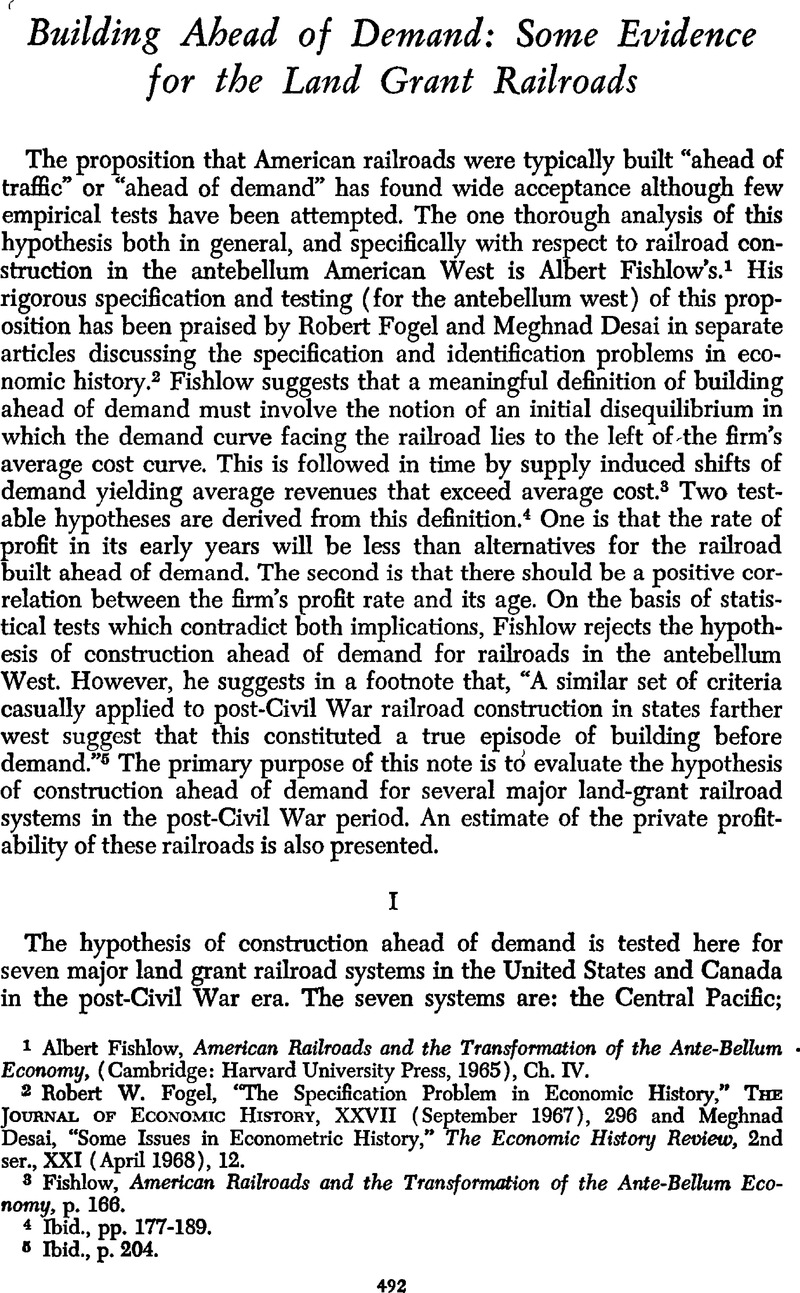Article contents
Building Ahead of Demand: Some Evidence for the Land Grant Railroads
Published online by Cambridge University Press: 11 May 2010
Abstract

- Type
- Notes
- Information
- Copyright
- Copyright © The Economic History Association 1974
References
1 Fishlow, Albert, American Railroads and the Transformation of the Ante-Bellum Economy, (Cambridge: Harvard University Press, 1965), Ch. IV.Google Scholar
2 Fogel, Robert W., “The Specification Problem in Economic History,” The Journal Of Economic History, XXVII (September 1967), 296Google Scholar and Desai, Meghnad, “Some Issues in Econometric History,” The Economic History Review, 2nd ser, XXI (April 1968), 12.Google Scholar
3 Fishlow, American Railroads and the Transformation of the Ante-Bellum Economy, p. 166.
4 Ibid., pp. 177–189.
5 Ibid., p. 204.
6 The railroad firms included in the formation of these systems are listed in Appendix A of my unpublished monograph, “Railroad Land Grant Policy and the Land Grant Railroads,” This is cited hereafter as “The Land Grant Railroads.” The systems include subsidiary roads leased or operated by the parent railroad with the result that the revenues of the parent and subsidiary or component roads are available in total but not individually. The number of railroad firms involved in the formation of each system as defined here is: Central Pacific (20); Union Pacific (47); Texas and Pacific (6); Atchison, Topeka and Santa Fe (30); Northern Pacific (36); Great Northern (15); and Canadian Pacific (24).
7 The period for each system is an approximation to the life of the original investment in the system starting with the first year of reported gross earnings.
8 The required estimates are detailed in “The Land Grant Railroads.” Gross capital earnings for each system are developed in Appendix B. Estimation of the gross investment streams is presented in Appendix A. Capital stocks is calculated by the perpetual inventory method in Appendix J. The double declining balance depreciation rates used are discussed in Chapter 4.
9 The earnings-price ratio is avalaible only beginning with 1871 and is from Alfred Cowles, 3rd and Associates, Common-Stock Indexes, 1871–1937 (Bloomington, Indiana: Principia Press Inc., 1938), p.404.Google Scholar The Snyder-Tucker general price index is used for all purposes with the U.S. systems while the Mitchell all-commodity index is used with the Canadian Pacific. The Snyder-Tucker index is from U.S. Bureau of the Census, Historical Statistics of the United States, 1789–1945 (Washington: U.S.G.P.O., 1949), Series LI-14, pp. 232–233.Google Scholar The Mitchell index is from Taylor, K.W. and Mitchell, H., Statistical Contributions to Canadian Economic History (Toronto: Macmillan Company of Canada, 1931) Vol. II p. 56.Google Scholar
10 There are two important alternative accounting measures for rates of return. One is the gross profitability ratio, i.e., the ratio of net earnings from operations (gross revenues minus variable operating costs) to cumulative investment expenditures (gross assets). The second is the net profitability ratio, i.e., the ratio of net income (net earnings from operations less depreciation) to net assets (gross assets minus cumulative depreciation). In “The Measurement of Corporate Rates of Return: A Generalized Formulation,” The Bell Journal of Economics and Management Science, II (Autumn 1971), 434–469Google Scholar, Thomas R. Stauffer has shown that both accounting ratios are inherently biased and do not equal the economic rate of return. The exception is the net profitability ratio which will equal the economic rate of return if the depreciation schedule used in the firm's accounts is defined at the time-rate-of-change of the present value of the cash flow stream.
11 There is a unique solution in each case. A terminal adjustment is necessary in the net receipts stream because investment expenditure through the end year is entered but the future earnings of the capital stock in existence in the end year are not counted. The adjustment made here is to add the value of the capital stock to the net receipts stream in the terminal year.
12 Still a further point of interest is the social rate of return for railroads built ahead of demand, if the (ex post) social rate of return is less than the opportunity cost of capital for a railroad built ahead of demand according to the Fishlow definition, the developmental significance of the railroad is limited even though it was “built ahead of demand.”
- 4
- Cited by




